The
Sule Paya
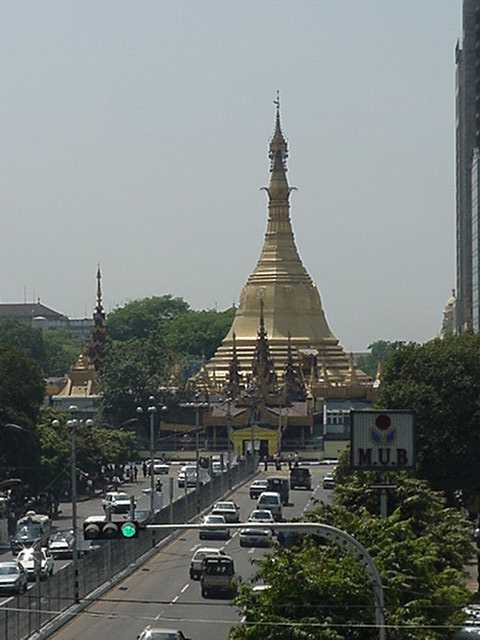 The
road that runs in front of Traders is Sule Pagoda Road, and the shrine
is visible from
The
road that runs in front of Traders is Sule Pagoda Road, and the shrine
is visible from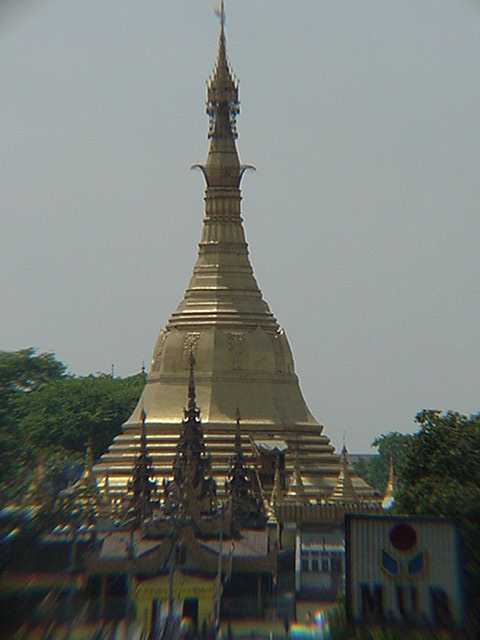 the hotel. The road actually dead ends into the shrine, whose golden
dome
or zedi contains a hair given by the Buddha to two Burmese merchants.
It
is reputedly over two thousand years old, all though it has been
through
so many renovations that its actual origins are obscure. Readily
accessible
from downtown, a visit to the Sule Pagoada or Paya (Paya is a term that
indicates a person or place of great spriritual value) it is a good
prelude
to the much more elaborate Shwedagon Paya, which is actually an entire
temple complex. Like Shwedagon, the Sule Paya is built in the typical
Burmese
Mon style, with the four entrances facing the four compass points. The
photo
to the left shows the approach to the north or main entryway,
overshadowed in this
picture
by the shrine's zedi, while a closer view of that entryway is shown in
the photo to the right. If the Shwedagon Pagoda is the spiritual heart
of
Yangon, the Sule Pagoda is the human center of worship, bustling with
common
folk, and lined with merchants.
the hotel. The road actually dead ends into the shrine, whose golden
dome
or zedi contains a hair given by the Buddha to two Burmese merchants.
It
is reputedly over two thousand years old, all though it has been
through
so many renovations that its actual origins are obscure. Readily
accessible
from downtown, a visit to the Sule Pagoada or Paya (Paya is a term that
indicates a person or place of great spriritual value) it is a good
prelude
to the much more elaborate Shwedagon Paya, which is actually an entire
temple complex. Like Shwedagon, the Sule Paya is built in the typical
Burmese
Mon style, with the four entrances facing the four compass points. The
photo
to the left shows the approach to the north or main entryway,
overshadowed in this
picture
by the shrine's zedi, while a closer view of that entryway is shown in
the photo to the right. If the Shwedagon Pagoda is the spiritual heart
of
Yangon, the Sule Pagoda is the human center of worship, bustling with
common
folk, and lined with merchants.
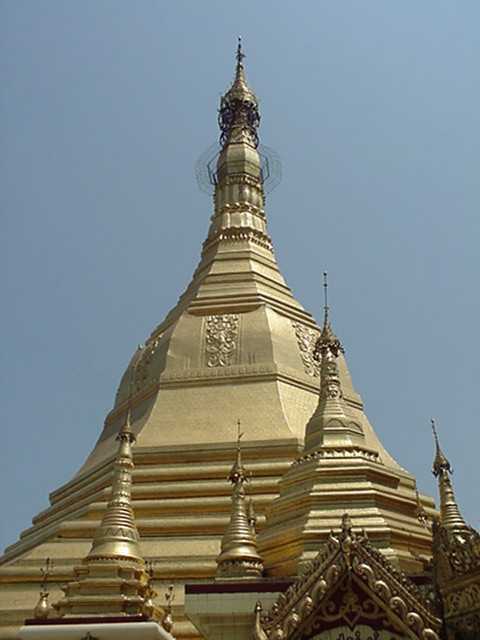
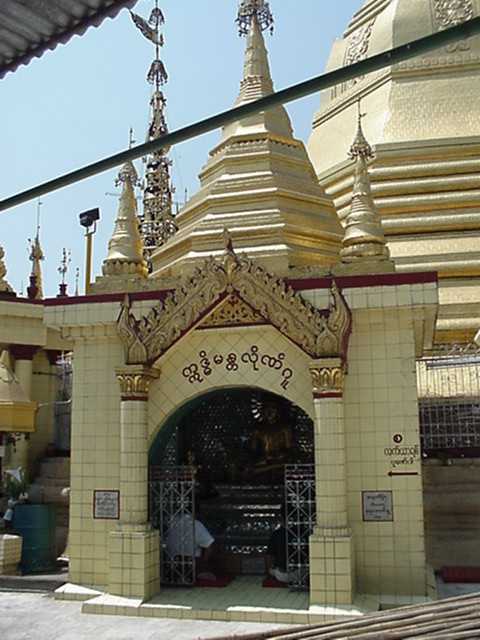 Entering
the shrine, the zedi is ringed by a series of shrines, each dedicated
to
a to different god. Each diety and shrine is assigned an astrological
sign, and
the entire circular pathway around the stupa represents a journey
through
the celestial sphere. The photo to the left captures the spires of
several
of the shrines, set against the backdrop of the central zedi. These
smaller
shrines (such as the one shown to the right) honor individual dieties
in
the Buddhist pantheon. The shrines themselves are small enclosures
housing
a silver, gold, or porcelain likeness of the diety. The devout enter
the
shrine and offer alms in the form of food or flowers as they petition
their respective god.
Entering
the shrine, the zedi is ringed by a series of shrines, each dedicated
to
a to different god. Each diety and shrine is assigned an astrological
sign, and
the entire circular pathway around the stupa represents a journey
through
the celestial sphere. The photo to the left captures the spires of
several
of the shrines, set against the backdrop of the central zedi. These
smaller
shrines (such as the one shown to the right) honor individual dieties
in
the Buddhist pantheon. The shrines themselves are small enclosures
housing
a silver, gold, or porcelain likeness of the diety. The devout enter
the
shrine and offer alms in the form of food or flowers as they petition
their respective god.
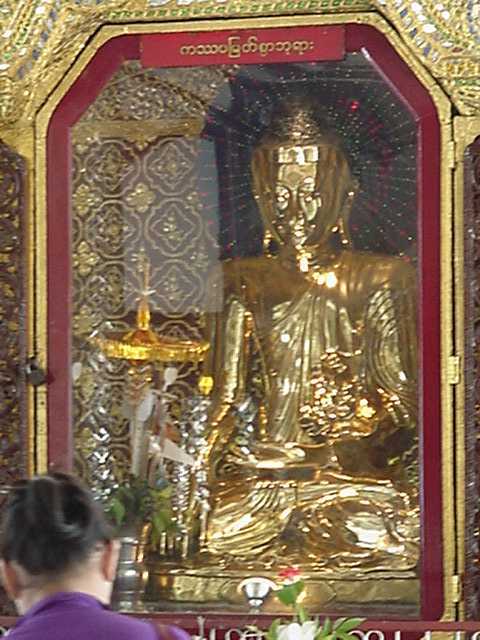 The
dieties occupying the four compass points are the most significant, as
they represent the historical incarnations of the Buddhas. The photo to
the right captures the central idol at the west entrance, the temple of
the Kassaga Buddha. the precusor to Siddhartha Gautama. The golden idol
is encased in a glass and gold leaf enclosure.
The
dieties occupying the four compass points are the most significant, as
they represent the historical incarnations of the Buddhas. The photo to
the right captures the central idol at the west entrance, the temple of
the Kassaga Buddha. the precusor to Siddhartha Gautama. The golden idol
is encased in a glass and gold leaf enclosure.

Return
to Yangon
Main
Page
 The
road that runs in front of Traders is Sule Pagoda Road, and the shrine
is visible from
The
road that runs in front of Traders is Sule Pagoda Road, and the shrine
is visible from the hotel. The road actually dead ends into the shrine, whose golden
dome
or zedi contains a hair given by the Buddha to two Burmese merchants.
It
is reputedly over two thousand years old, all though it has been
through
so many renovations that its actual origins are obscure. Readily
accessible
from downtown, a visit to the Sule Pagoada or Paya (Paya is a term that
indicates a person or place of great spriritual value) it is a good
prelude
to the much more elaborate Shwedagon Paya, which is actually an entire
temple complex. Like Shwedagon, the Sule Paya is built in the typical
Burmese
Mon style, with the four entrances facing the four compass points. The
photo
to the left shows the approach to the north or main entryway,
overshadowed in this
picture
by the shrine's zedi, while a closer view of that entryway is shown in
the photo to the right. If the Shwedagon Pagoda is the spiritual heart
of
Yangon, the Sule Pagoda is the human center of worship, bustling with
common
folk, and lined with merchants.
the hotel. The road actually dead ends into the shrine, whose golden
dome
or zedi contains a hair given by the Buddha to two Burmese merchants.
It
is reputedly over two thousand years old, all though it has been
through
so many renovations that its actual origins are obscure. Readily
accessible
from downtown, a visit to the Sule Pagoada or Paya (Paya is a term that
indicates a person or place of great spriritual value) it is a good
prelude
to the much more elaborate Shwedagon Paya, which is actually an entire
temple complex. Like Shwedagon, the Sule Paya is built in the typical
Burmese
Mon style, with the four entrances facing the four compass points. The
photo
to the left shows the approach to the north or main entryway,
overshadowed in this
picture
by the shrine's zedi, while a closer view of that entryway is shown in
the photo to the right. If the Shwedagon Pagoda is the spiritual heart
of
Yangon, the Sule Pagoda is the human center of worship, bustling with
common
folk, and lined with merchants.


